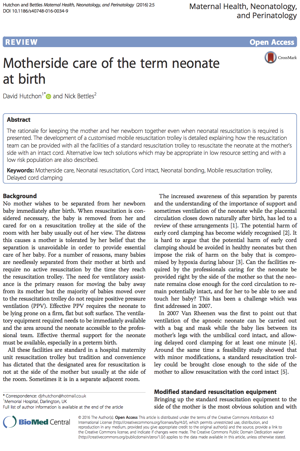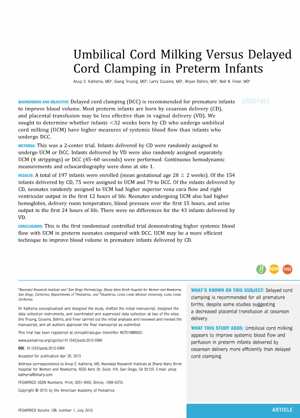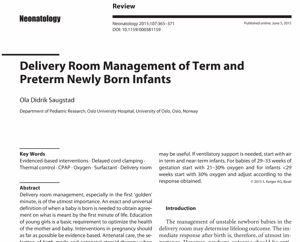The timing of umbilical cord clamping has been a topic of considerable debate in the medical community, particularly concerning preterm infants. A recent study aimed to shed light on this issue and understand how early or delayed cord clamping affects the health outcomes of these vulnerable newborns.
Methodology:
Researchers conducted a study involving 96 pregnant women eagerly awaiting the arrival of their babies. The participants were randomly assigned to one of two groups - early cord clamping (ECC) or delayed cord clamping (DCC). The researchers closely monitored hematological and cardiac changes in the preterm infants, focusing on gestational periods between 24 and 34 weeks, and evaluated the stability of key blood parameters within the first week after birth.
Key Findings:
The study revealed interesting insights into the impact of cord clamping timing. Infants in the DCC group showed higher levels of hemoglobin and hematocrit upon admission, indicating improved oxygen-carrying capacity compared to those in the ECC group. Similarly, by the seventh day of life, the DCC group maintained higher hemoglobin and hematocrit levels, suggesting continued hematological advantages.
However, it should be noted that the DCC group also had a slightly higher incidence of phototherapy usage to treat jaundice compared to the ECC group.
Cardiac parameters and maternal blood tests did not differ significantly between the two groups.
Conclusion:
The study suggests that delayed cord clamping may have certain benefits for preterm infants in terms of hematological outcomes, as evidenced by higher hemoglobin and hematocrit levels. However, it is important to consider that other factors, such as a slightly increased need for phototherapy, should be taken into account.
This study adds valuable insights to the ongoing discussion regarding the optimal timing for cord clamping in preterm births. Further research is warranted to better understand the long-term implications and overall health outcomes associated with cord clamping practices.
Reference: García, C., Prieto, M.T., Escudero, F., Bosh-Giménez, V., Quesada, L., Lewanczyk, M., Pertegal, M., Delgado, J.L., Blanco-Carnero, J.E., De Paco Matallana, C., 2023. The impact of early versus delayed cord clamping on hematological and cardiovascular changes in preterm newborns between 24 and 34 weeks’ gestation: a randomized clinical trial. Archives of Gynecology and Obstetrics.. https://doi.org/10.1007/s00404-023-07119-0
Dynamics of Umbilical Cord Circulation: During gestation, the fetus relies on the circulation of blood through the umbilical cord to exchange oxygen, carbon dioxide, nutrients, and waste products with the placenta. The fetus and the placenta develop a delicate balance in distributing blood to promote growth and development. Doppler velocimetry of the uteroplacental and fetoplacental circulations is commonly used by obstetricians to assess fetal growth restriction.
Placental Transfusion: After birth, part of the blood contained in the placenta can be transferred back to the newborn, known as placental transfusion. There are several methods to indirectly assess the size of placental transfusion. One such method is measuring the residual placental blood volume (RPBV) after cord clamping. Studies have shown that RPBV decreases from approximately 109 ml to 17 ml when cords are clamped immediately, indicating a smaller transfusion. Similarly, comparing the weight of babies after early and delayed cord clamping shows an average weight gain of 86-96 g in delayed clamping cases, corresponding to a placental transfusion of approximately 30 ml/kg.
Other methods to indirectly demonstrate placental transfusion include measuring neonatal blood volume, which has shown an increase of 14-20 ml/kg in delayed cord clamping cases. Hematocrit and hemoglobin levels in neonates have consistently been found to be higher after delayed cord clamping, with differences of approximately 1.5 g/dL and 10%, respectively. Improved iron stores have also been observed up to 8 months after birth in cases of delayed cord clamping.
Beneficial Effects and Optimal Timing: Delayed cord clamping has been associated with numerous benefits, such as improved iron stores, reduced anemia, enhanced neurodevelopment, and lower transfusion requirements in preterm infants. Studies have shown that waiting at least 2-3 minutes after birth for cord clamping is recommended to achieve optimal outcomes.
Conclusion: Understanding the dynamics of umbilical cord circulation and placental transfusion is essential for healthcare professionals and individuals interested in medicine. Through a review of extensive literature, it is clear that delayed cord clamping leads to various benefits for newborns. Recommending a minimum of 2-3 minutes for cord clamping after birth can help optimize outcomes. Further research and ongoing studies, such as the SAVE-study, contribute to our understanding of sustained cord circulation and its implications for neonatal health.
Read more: https://doi.org/10.1016/j.semperi.2023.151739
Two of the persons involved in the development of Lifestart trolley (http://www.inditherm.com/medical/neonatal-resuscitation-lifestart/) has published a review in Maternal Health, Neonatology and Perinatology.
"Abstract: The rationale for keeping the mother and her newborn together even when neonatal resuscitation is required is presented. The development of a customised mobile resuscitation trolley is detailed explaining how the resuscitation team can be provided with all the facilities of a standard resuscitation trolley to resuscitate the neonate at the mother’s side with an intact cord. Alternative low tech solutions which may be appropriate in low resource setting and with a low risk population are also described."
http://mhnpjournal.biomedcentral.com/articles/10.1186/s40748-016-0034-9
In a recent article in Pediatrics, Dr. Anup Katheria and co-workers reports on a randomized trial comparing umbilical cord milking (4 times stripping) and delayed umbilical cord clamping (45-60 sec) in 197 preterms.
Among the preterms, Katheria & al choose to emphasize the findings from a large sub-group in the trial, those born by cesarean delivery, Out of 154, 75 were assigned to milking and 79 to delayed clamping.
Interesting outcomes:
- There were no differences between the two groups among infants born vaginally.
- Among those born by cesarean delivery, umbilical cord milking resulted in higher hemoglobin, delivery room temperature, blood pressure over the first 15 hours, and urine output in the first 24 hours of life.
- No differences in in cerebral saturations or impedance-derived cardiac output or stroke volume were seen between the infants.
cordclamping.org interpretation:
This is, to the authors (and my own) knowledge the first study that directly compares umbilical cord milking and delayed clamping after cesarean delivery. The primary outcome of the study was superior vena cava flow within the first 12 hours. As there were no differences between groups in this outcome, the authors have chosen to select both the outcomes to highlight and also mainly reported outcome after only cesarean delivery. This type of selective reporting should be interpreted with caution, and conclusions should be made carefully until additional studies confirm the findings. (That said, we did the same thing with our paper in JAMA Peds)
The interesting finding that milking would provide a larger placental transfusion of blood to the preterm newborn is also open for some questions. The authors do tell us that delaying for 45 seconds is quite a long time for a preterm trial, but you might always wonder if delaying for a longer while would have ameliorated the differences shown? We are also starting to be more observant on initiation of breathing and placental blood flow (by the research of Stuart Hooper & al) – implying that it is preferable to wait to clamp the cord until after the baby has started breathing or positive pressure ventilation is provided – I can’t find any data on this in the article.
Recently a study including 67 preterms (< 32 weeks) comparing delayed clamping for 30 seconds with adding milking 2 times after 30 seconds of cord clamping couldn’t show any additional effect. Also, in 2011, Rabe & al compared delayed clamping after 30 seconds with milking 4 times and did not show any significant differences among the included 58 neonates.
Gradually, and in many peoples opinion, too slowly, we are learning more and more about the effects of waiting to clamp the cord and/or umbilical cord milking. It is believed that the most vulnerable newborns 8the extremely preterms and those undergoing asphyxia) are the ones who might profit the most of these methods, and more and more data is confirming this. Still, it is clear that more studies has to be made to help us understand the physiology of what happen with the placentas and babies circulation at birth under different circumstances.
Take home message:
After cesarean delivery, umbilical cord milking might provide premature babies with a higher blood volume than delaying to clamp the cord for approximately 45 seconds.
Katheria, A., Truong, G., Cousins, L., Oshiro, B. & Finer, N. Umbilical Cord Milking Versus Delayed Cord Clamping in Preterm Infants. PEDIATRICS (2015).doi:10.1542/peds.2015-0368
www.pediatrics.org/cgi/doi/10.1542/peds.2015-0368
Neonatology has published a review by Ola Didrik Saugstad, professor at Department of Pediatric Research, Oslo University Hospital in Norway on delivery room management of term and preterm newly born infants.
Concisely written, professor Saugstad mentions several relatively new concepts, such as sustained inflations and less invasive surfactant administration. Also when it comes to cord clamping he is generally positive to delay umbilical cord clamping for both term and preterms grounded on the evidence shown through research.
As for resuscitation with an unclamped cord he writes: ‘However, these babies probably need their placental blood most. New trolleys have been constructed to make it possible to initiate resuscitation with an intact umbilical cord and such practice needs to be assessed in randomized clinical trials.’
According to professor Saugstad, cord milking seems to be an alternative to delayed cord clamping in preterm babies.
He also adds another interesting perspective in his review. If delayed cord clamping contributes with 20-30 ml/kg extra blood to the newborn, the birth weight will be higher (shown in the latest Cochrane review to be approximately 100 grams) and, as current growth charts in most, if not all, are based predominantly on early cord clamping, new growth charts might be needed if delayed cord clamping is implemented widely!
Anup Katheria and co-workers has done some very interesting observations on term newborns who didn't have their umbilicl cord clamped. Transcutaneous sensors were placed on the neck and chest to determine heart rate, stroke volume and cardiac output at each beat. Cardiac output increased from 2 to 5 minutes of life (p = 0.008). For every minute of life the cord was kept unclamped, the stroke volume increased 13.1% ± 12.3 (p = 0.0001) and cardiac output increased 12.6% ± 6.3 from baseline (p < 0.0001).
Katheria, A. et al. Measuring cardiac changes using electrical impedance during delayed cord clamping: a feasibility trial.Maternal Health, Neonatology and Perinatology (2015). doi:10.1186/s40748-015-0016-3
http://www.mhnpjournal.com/content/1/1/15/abstract
OBJECTIVE:
Autologous blood transfusion from the placenta to the neonate at birth has been proven beneficial. Transfusion can be accomplished by either delayed cord clamping or cord stripping. Both are equally effective in previous randomized trials. We hypothesized that combining these 2 techniques would further improve outcomes in preterm neonates.
STUDY DESIGN:
This was a prospective randomized trial for singleton deliveries with estimated gestational ages between 22 and 31 6/7 weeks. The control protocol required a 30-second delayed cord clamping, whereas the test protocol instructed a concurrent cord stripping during the delay. The primary outcome was initial fetal hematocrit. We also examined secondary outcomes of neonatal mortality, length of time on the ventilator, days to discharge, peak bilirubin, number of phototherapy days, and neonatal complication rates.
RESULTS:
Of the 67 patients analyzed, 32 were randomized to the control arm and 35 were randomized to the test arm. The gestational ages and fetal weights were similar between the arms. Mean hematocrit of the control arm was 47.75%, and the mean hematocrit for the test arm was 47.71% (P = .98). These results were stratified by gestational age, revealing the infants less than 28 weeks had an average hematocrit of 41.2% in the control arm and 44.7% in the test arm (P = .12). In the infants with gestational ages of 28 weeks or longer, the control arm had an average hematocrit of 52.9%, which was higher than the test arm, which averaged 49.5% (P = .04). The control arm received an average of 1.53 blood transfusions, whereas the test arm received 0.97 (P = .33). The control arm had 3 neonatal deaths, and the test arm had none (P = .10). The average number of days until discharge was 71.2 for the control arm and 67.8 for the test arm (P = .66). The average number of days on the ventilator was 4.86 for the control arm and 3.06 for the test arm (P = .34).
CONCLUSION:
Adding cord stripping to the delayed cord clamp does not result in an increased hematocrit. Data suggest trends in lower mortality and higher hematocrit in neonates born less than 28 weeks, but these were not statistically significant.
Krueger MS, Eyal FG, Peevy KJ, et al. Delayed cord clamping with and without cord stripping: a prospective randomized trial of preterm neonates. Am
J Obstet Gynecol 2015;212:394.e1-5
http://dx.doi.org/10.1016/j.ajog.2014.12.017
In this randomised trial, Tiemersma and coauthors randomised 104 vaginally born infants to either early (< 30 s) or delayed (120-180 s) clamping. Infants were supposed to be low birth weight, why only those less than 3000 g were included.
After birth, the baby was placed on the mother's abdomen. Oxytocin was given immediatly after birth in both groups.
Interesting outcomes:
- Hemoglobin and hematocrit was higher after 24 hours: implying a successful placental transfusion
- There were no statistical difference in having a serum bilirubin over threshold: 16% (n=9) in the early clamped group and 6% (n=6) in delayed group.
- At follow up two to three months after birth, there were no differences in hemoglobin or iron statusb etween groups, but the infants in the DCC group may have had a better weight gain from baseline than those with ECC (2.2 kg vs 1.9 kg).
This study has a very good intention; to study cord clamping in low birth weight (< 2.5 kg) newborns. We need more data in this area, especially on newborns that have had intra uterine growth restriction. Importantly, the study could not show any higher occurence of hyperviscosity or hyperbilirubinemia in the DCC group, in congruence with most other recenr studies, and in opposition to what a lot of people believe.
As for the results at 2-3 months, the authors unfortunately not seem to have adjusted for the exact age at measurement. It is not possible to rule out that that the DCC group hade their follow-up some days or weeks after the ECC group, which could explain the higher weight gain. As ferritin levels decline fast during the first months of life, this might explain why the expected difference in ferritin levels beween the DCC and ECC groups was not found. The attrition rate of 30% is quite high.
Take home message:
Delayed cord clamping for 2-3 minutes was not associated with any higher occurence of hyperviscosity or hyperbilirubinemia after 24 hours, as compared to early cord clamping.
Tiemersma S, Heistein J, Ruijne R, Lopez G, van Lobenstein J, van Rheenen P. Delayed cord clamping in South African neonates with expected low birthweight: a randomised controlled trial. Trop Med Int Heal. 2015;20(2):177-183.
doi:10.1111/tmi.12419.
Senaste inläggen
- New Study Explores the Impact of Cord Clamping Timing on Preterm Infants
- Understanding the Dynamics of Umbilical Cord Circulation and Placental Transfusion: Debunking Commo…
- New review: Motherside care of the term neonate at birth
- Delayed clamping vs. milking in preterm infants
- Review on delivery room management of newly born infants
- Cardiac changes during delayed cord clamping
- Delayed cord clamping with and without cord stripping: a prospective randomized trial of preterm ne…
- Delayed cord clamping in South African neonates with expected low birthweight
 0 kommentarer
0 kommentarer 







Israel Brown » Major break-through for delayed cord clamping: ”It is worth taking such a recommendation . However, cord milking in both preterm..”
Dr Robyn Thompson » Major break-through for delayed cord clamping: ”Midwives with women have not been practising early cord clamping for decades tha..”
Sally » Major break-through for delayed cord clamping: ”What's the number of babies needing photo therapy for term babies., talk about i..”
Tonia » Major break-through for delayed cord clamping: ”The picture in this article shows a placenta several minutes after delivery. The..”
Steve Kabamba » Major break-through for delayed cord clamping: ”What is the stand in the High burden HIV population? What is the risk of contrac..”